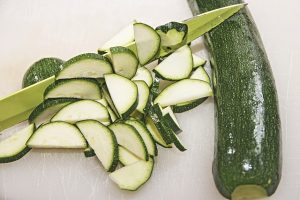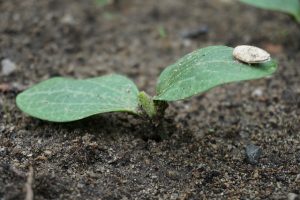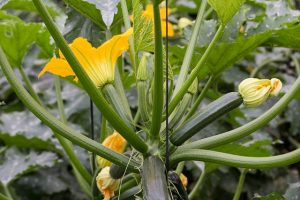Courgettes come thick and fast in any garden once they are established. Even with just three plants, it is possible to be inundated with these versatile vegetables. There is always the hope the plants remain as prolific as possible throughout summer and into early autumn. In the USA, courgettes are known as Zucchini.

To be rewarded by their high productivity is straightforward as long as they are grown in relatively warm, sheltered areas which are free of frosts and are watered well. They are hungry plants so they need a small amount of preparation to help grow. The sunniest place should be possible with plenty of organic matter dug into the growing area around autumn time which helps feed the crops and retains moisture in the soil as well as throughout the whole season. The issues with courgettes are similar to those of all the Curcurbits such as pumpkins and squashes.
Sow: April – May
Harvest: August – October.
Seed Sowing Indoors
Seeds are best sown indoors in the UK in individual pots from late March to May. The seeds are ideally sown on their edge to a depth of 1 cm-1.5cm (1/2 in.) deep to prevent rotting in pots. Use pots of 7.5cm.
No need to sow a couple to together and then select the weakest as this isn’t relevant unless losses are expected.
The best time is April to May under glass at 20 to 25 Centigrade using good quality seed sowing or free-draining compost. If doing an early sowing, place the pots in a propagator or a sealed bags.
Seed Sowing Outdoors
The alternative is to sow seeds in the manner as before but outdoors between mid-May to June in the UK direct into the growing site 1.5cm (1/2in.) deep with 2 or 3 seeds in each position at 60cm (24 inches) apart. Some growers claim that cv. ‘All Green Bush’ will take an outdoor sowing in April but it has never worked for me.
I’ve sown seeds directly into warm compost between April and June although it depends on variety. It usually means later crops but can avoid a ridiculous glut !
Continue to water well but allow a little drying to avoid this rotting off.
Growing On Courgettes (First Phase).
The seedlings emerge after 7 to 10 days, so keep the compost moist but not overly wet and rotate these pots so they receive even light exposure throughout the growing period. Place in a light, sunny area where the annual temperature will be up to 20 °C which is perfect. The growing conditions can be a little cooler too but not cold – keep them at the lower temperatures in the greenhouse for 10 to 15 days.
The seedlings are placed outside to harden off once 3 or 4 leaves have formed and any risk of frost has gone. Look for the first pair of rough leaves. The site to transplant to should be about late May to early June.

Growing On Courgettes (Second Phase)
A hole is dug in which the plant is to grow and filled with a mix of well-rotted manure and compost. I use a ridge of removed soil around the growing plant to help contain the water during watering.
All plants are placed at least 60cm (24 inches) apart so that their roots develop properly. The young plants are transplanted carefully, firmed in with the heel of the boot and then well watered. All seedlings are handled by their leaf rather than the stem to avoid damaging the plant.
If you outdoor sowed the seeds, reduce the number of plants to one per station.
By the way it is possible to grow courgettes in a large pot. It helps with watering and is especially useful with other squashes.
Further Care Of Courgettes
Any early sowings and young plants benefit from cloche protection during the early months unless they are sheltered. Expect to see male yellow flowers to begin with.
Maintain watering and use a balanced liquid feed like Growmore which is not nitrogen-rich, once the fruits have begun to develop. All courgettes need to be picked when they have length from 10cm or 12 cm onwards. Expect to pick between August and October.
There are some mini-varieties which are more prolific and need to be picked more often. The formation of fruits should be highly regular and many can be frozen accordingly.
If you see silvery blotches on the leaves of plants do not worry. These are not signs of disease but a natural characteristic of the leaf colouring.

Issues With Setting or Keeping Fruits
Courgettes are not without their problems. Very often baby courgettes will rot off before reaching a harvestable size. At other times they swell at the top and then taper towards the base which also subsequently rots. These problems are caused by poor pollination which is usually weather dependent. Any cold and bees or other insects which normally pollinate the flowers go missing. Such symptoms generally disappear as the summer moves on but providing a sheltered site should help. Some self-setting varieties like ‘Parthenon’ are available which do not require any insect pollination.
There are times when some plants only produce male flowers which are non-fruiting and a few female ones which then set. The male flowers are recognised by their long spindly stems.
There can often be slug or snail damage – just depends. Vigilance should also be made for mice and rats eating the produce which is characterised by the skin having been gnawed away from the developing fruit.
Declining day length especially towards the end of September, too little water which induces root stress and too high a nitrogen feed can also be problematic for flower setting.
Viruses produce distinct yellow veins in leaves and then produce distorted flowers and fruits. There is no cure and it is simply best to discard the plant and grow some resistant strains like ‘Defender’.
Blossom End Rot
Blossom End Rot is another bugbear of courgette growers. We’ve already mentioned poor pollination for loss of fruit but blossom end rot is a real problem. It also affects peppers (capsicums) and tomatoes too.
The courgettes starts growing and get to about 5 cm long before turning yellow at the end and also dropping off. Even with feeding, watering and removal of any leaves through powdery mildew but still the courgette is blighted.
The main cause is lack of calcium and magnesium which means adding a high quality feed containing these minerals to any water. The other issue is irregular watering where the plant dries out and is then heavily watered. watering does need to be consistent. It helps to apply some lime to correct for any mineral deficiencies.
Varieties Of Courgettes
Courgettes come in many shapes and sizes. I have tried a variety from the highly European type like ‘Romesco’ which looks like a mini marrow, to ‘Tondo’ and Eight-Ball which are both round varieties. The Italian variety is ‘Zucchini’ which is slightly ridged and has a finer taste than other counterparts. The yellow varieties always add variety and there are some which offer quite bent shapes. One that I have grown regularly is ‘Black Bomber’ which is a very smooth dark skinned type. ‘Defender’ is a virus resistant variety. A nice little variety is ‘Eclipse’ which produces small ball shaped fruits with attractive green stripes. These are offered by Thompson & Morgan.
Please note this page contains links to our affiliate marketing partner. Please read our affiliate disclosure.
cv. All Green Bush – As with many courgettes, this variety has deep, glossy green skin and a tender centre, but it can also be picked at just 7.5cm long. This makes it ideal for cooking whole. This variety is claimed to be one of the earliest maturing and has a long cropping period so harvest all summer long. Similar to the variety called ‘Green Bush’ below.
cv. Ambassador – the standard variety for courgettes in most retailers. A quick-maturing variety, producing cylindrical fruits on a plant with a open habit and few side shoots.
Ambassador lacks the yields and uniformity of more modern hybrids such as Tristan, but its reliability still makes it a hit with amateur gardeners.
cv. Atena – a new early hybrid variety that is heavy cropping. The plants are semi-compact, which is ideal for small gardens. The beautiful yellow fruit is relatively straightforward to collect. Other varieties include Atena Polka F1 which is available from Kings Seeds.
The fruits are best picked when about 15-20cm in length. Good sweet flavour, ideal for tagines and stir-fry.
cv. Eight Ball – a hybrid courgette variety of dark green, uniform, round fruits. It offers better cropping with higher yields than open pollinated round varieties.
Eight Ball has a bush habit and is grown as per normal courgettes, but do not let them get too big as they taste best when picked small. Works well in combination with the F1 OneBall variety.
cv. Green Bush generates striped attractive fruits. Can be picked as standard sized courgettes, or allowed to mature into full-size marrows.
cv. Lungo Bianco – Italian heritage variety. A bush-style courgette is a real looker, producing light green, creamy, almost white fruit. Very smooth skin with a mild and sweet flavour. Also a productive variety which is best picked when it is around 15-20cm (6-8inches), although it will grow bigger if you let it. Try sliced when thick, rubbed with garlic and cooked on the barbecue (www.dobies.co.uk)
cv. One Ball is a novelty bright yellow round fruited hybrid courgette variety. Grow as per normal courgettes, but do not let them get too big as these have a better flavour when small. Often with the F1 Eight Ball.
cv. Parthenon F1. A unique variety which can pollinate itself and thereby produce fruit early in the season and in cool weather. This also makes it ideal for growing under cloches. Beautiful glossy, dark green fruits. (www.organiccatalogue.com)
cv. ‘Shooting Star F1’ Perfect for a small space: a climbing yellow courgette for planting in a sunny border by the fence or for use in containers by a wall. Needs a trellis to scramble through and some tying-in of stems, but for a little work a great crop is obtained of these particularly delicious courgettes (www.marshall-seeds.co.uk)
cv. ‘ Soleil F1’. Intensely bright, yellow skinned, very straight fruits produced on compact, yet vigorous plants. Has the added bonus of tolerance to powdery mildew and is very high yielding. (www.mr-fothergills.co.uk)
cv. ‘Syros F1’. Compact, bushy, spine-free plants ideal for patio containers but also for garden growing. The tasty, dark green fruit are produced on longer stalks for ease of harvest. It also boasts excellent powdery mildew resistance, which means harvesting can continue for longer. The variety is also resistant to mosaic virus. Now a much improved variety. Seeds obtainable from www.dobies.co.uk
Leave a Reply